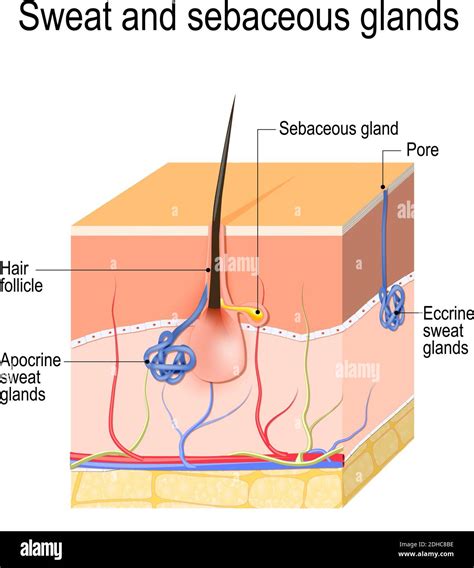Understanding Sweat Glands: Our Body’s Natural Cooling System
Sweat glands, also known as sudoriferous glands, are small tubular structures in the skin that produce sweat. Their primary function is to regulate body temperature through evaporative cooling, but they also play a minor role in excretion. Humans possess millions of these glands, distributed across most of the body’s surface, making them vital components of our physiological well-being. But how do the numbers compare between sexes?

Types of Sweat Glands: Eccrine and Apocrine
Before diving into numbers, it’s important to distinguish between the two main types of sweat glands:
- Eccrine Glands: These are the most numerous and are found over most of the body surface, particularly on the palms of the hands, soles of the feet, and forehead. They produce a clear, watery, odorless sweat that is crucial for thermoregulation.
- Apocrine Glands: Primarily located in the armpits, groin, and around the nipples, these glands develop during puberty. Their sweat is thicker, contains fatty acids and proteins, and becomes odorous when broken down by skin bacteria. Apocrine glands are less involved in thermoregulation and are often linked to stress-induced sweating and scent production.
When discussing the “number of sweat glands” in the context of thermoregulation, the focus is predominantly on eccrine glands due to their widespread distribution and primary role in cooling.

Average Number of Sweat Glands: A General Overview
The total number of sweat glands in an adult human can range significantly, typically between 2 to 5 million. This wide range is influenced by genetics, ethnicity, and even the climate in which a person grew up (acclimatization). Interestingly, while the number of glands is largely set before birth, their activity can be influenced throughout life.
Male vs. Female: A Nuanced Comparison
When comparing males and females, scientific studies reveal a fascinating and somewhat counter-intuitive pattern:
Historically, research has suggested that females tend to have a higher average number of sweat glands than males. Some studies indicate that women may have up to 20-30% more sweat glands on certain parts of their body, like the torso and limbs, compared to men. However, this numerical advantage doesn’t necessarily translate to greater sweat output.
Conversely, males generally exhibit higher sweat rates and produce more sweat overall during physical activity or heat exposure. This is because, while females may have more glands, male sweat glands tend to be larger and, crucially, become more active and efficient at producing sweat. Several factors contribute to this difference:
- Body Size and Surface Area: Males typically have a larger average body mass and surface area, requiring more evaporative cooling to maintain core temperature.
- Muscle Mass: Men generally have a higher proportion of muscle mass, which generates more heat during activity, necessitating greater sweat production.
- Hormonal Influences: Hormonal differences, particularly testosterone levels in men, can influence gland size and activity, leading to a more robust sweating response.
- Metabolic Rate: Males often have a higher resting metabolic rate, producing more heat even at rest, which contributes to their overall sweating capacity.
- Acclimatization: Both sexes can acclimatize to hot environments, increasing the efficiency and output of their sweat glands, but inherent physiological differences persist.

Implications for Thermoregulation
These differences in sweat gland number and activity have direct implications for how males and females regulate their body temperature. While women may possess more individual cooling units, men’s larger and more active glands allow for a greater volume of sweat to be produced and evaporated, particularly during strenuous activity or in hot conditions. This contributes to men often having a higher capacity for heat dissipation through sweating.

Conclusion
In summary, while the average human possesses millions of sweat glands, with estimates ranging from 2 to 5 million, there are discernible differences between the sexes. Females generally tend to have a greater absolute number of sweat glands. However, males typically compensate for this by having larger and more active glands, coupled with greater body mass and muscle, leading to a higher overall sweat rate during heat stress or exercise. This physiological distinction highlights the intricate and often nuanced ways in which human bodies adapt and maintain homeostasis.





